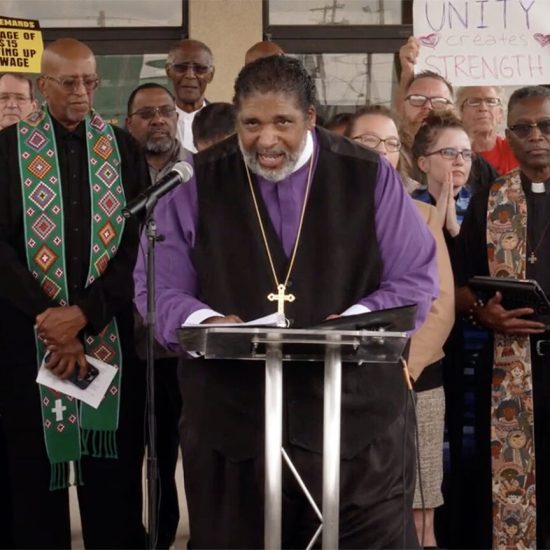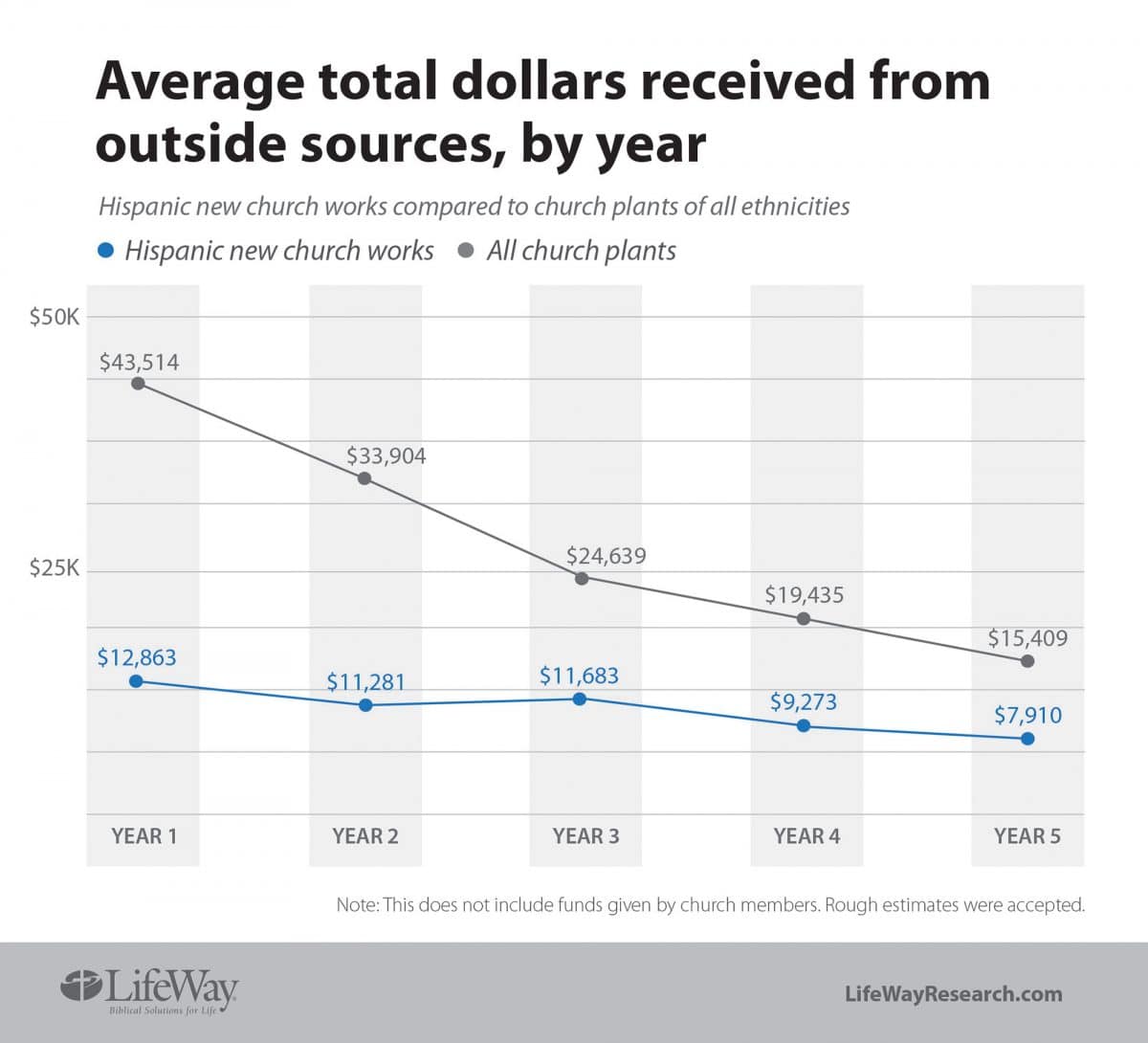
NASHVILLE (BP) — New Hispanic church works in the U.S. are reportedly seeing similar patterns of attendance growth and conversions as other church plants despite having a fraction of the financial support and training. This, in addition to facing complications from the immigration status of members and leaders, according to a new study released Wednesday (July 24).
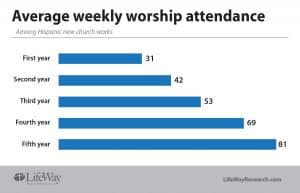 “Evangelical groups who are starting new churches are starting Hispanic churches,” said Scott McConnell, executive director of LifeWay Research.
“Evangelical groups who are starting new churches are starting Hispanic churches,” said Scott McConnell, executive director of LifeWay Research.
LifeWay Research surveyed leaders from more than 200 new Hispanic church works from 14 Protestant denominations. And the study, conducted March 15–June 26, revealed most of the pastors and members were born outside of the U.S.
Among the lead pastors of these churches, 94 percent are Hispanic and 80 percent are first-generation immigrants. Around 1 in 12 (8 percent) say they were born in the U.S. But one or both of their parents were born elsewhere, and 12 percent say both they and their parents were born in the U.S.
One in 4 pastors (25 percent) say some of their church leaders have undocumented status. Around 2 in 3 (64 percent) say none of their church leaders have undocumented status and 11 percent prefer not to answer.
Within the churches, pastors estimate 89 percent of their congregation is Hispanic or Latino. Two-thirds (66 percent) were born outside of the U.S., while 22 percent are second-generation immigrants and 12 percent are third generation.
 Pastors say most of their congregation are citizens with permanent legal status (68 percent), while they estimate 21 percent of those in their church have undocumented status and 11 percent have temporary legal status.
Pastors say most of their congregation are citizens with permanent legal status (68 percent), while they estimate 21 percent of those in their church have undocumented status and 11 percent have temporary legal status.
Two-thirds of new Hispanic church works (64 percent) conduct their services completely in Spanish. And three-fourths (73 percent) say they have no plans to change the language(s) used in their church.
The new Hispanic work congregations are, in large part, middle aged, with 40 percent being 30 to 49 years old. Around 1 in 5 (21 percent) in the church are under 18, 16 percent are 18 to 29, and 23 percent are 50 and older.
“While most of the leaders of these churches are first-generation immigrants themselves,” said McConnell, “most have been in the area their church serves for 10 years or more.”
Similar growth with fewer resources
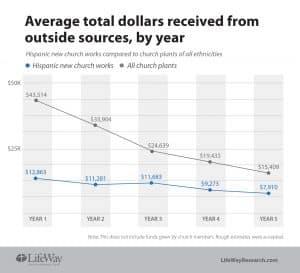 As with most other church plants, new Hispanic church works see exponential growth during the first few years. The average attendance in the church’s first year is 31. That climbs to 42 by the second year, 53 in year three, 69 in the fourth year and 81 after the fifth.
As with most other church plants, new Hispanic church works see exponential growth during the first few years. The average attendance in the church’s first year is 31. That climbs to 42 by the second year, 53 in year three, 69 in the fourth year and 81 after the fifth.
While those numbers are smaller than other church plants, they have similar growth trajectories. A similar 2015 LifeWay Research study of 843 Protestant church plants found the average new church began with 51 people in weekly worship attendance and grew to 146 by the fifth year.
The same is true for the number of conversions. In the first year, Hispanic church leaders say their church saw 10 first-time commitments to Jesus. That climbed to 13 in the second year and 15 in years three and four.
Among all church plants in the 2015 study, an average church saw 11 conversions in the first year, 14 in the second, 18 in the third and 17 in year four.
Similar to all church plants, around 4 in 10 attendees in new Hispanic works are completely unchurched or have been for many years. However, Hispanic churches are reaching a higher percentage of those who are completely unchurched (26 percent to 18 percent).
“Though new Hispanic church works start out smaller, they are more evangelistically effective per person,” McConnell said.
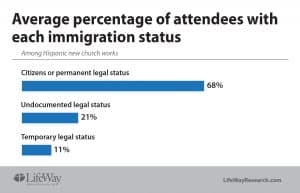 In order to start their church, 60 percent of pastors of new Hispanic works say they received funding from their denomination, compared to 72 percent of all church plants.
In order to start their church, 60 percent of pastors of new Hispanic works say they received funding from their denomination, compared to 72 percent of all church plants.
Fewer Hispanic church starts say they receive funding from a sponsoring congregation (45 percent to 56 percent).
In total, Hispanic new church work pastors say they receive an average of less than $13,000 in their first year from outside sources, which drops to less than $8,000 in the fifth year. By comparison, overall, church plants average more than $43,000 of outside funding in their first year. Even by their fifth year, the average church plant receives more money from others ($15,409) than the new Hispanic work receives its first year.
Similarly, new Hispanic churches receive, on average, $13,617 from church members and attendees in their first year. That climbs to $33,782 by year four, which is less than what the average church plant collects from attendees in their first year ($46,191).
Fewer than a third of Hispanic church plants have received church starting training that specifically incorporates the dynamics of a Hispanic/Latino context.
“Raising funds from individual donors may include cross-cultural challenges,” McConnell said. “But there is no valid justification for the funding inequities Hispanic church starts experience especially at the denominational level.”
 Among the 61 percent of Hispanic church starts with a sponsoring church, however, they are more likely than all church plants with a sponsoring church to say they received support like using a church building, having the sponsoring church’s pastor preach occasionally, helping with administrative needs, and providing training.
Among the 61 percent of Hispanic church starts with a sponsoring church, however, they are more likely than all church plants with a sponsoring church to say they received support like using a church building, having the sponsoring church’s pastor preach occasionally, helping with administrative needs, and providing training.
Pastors of new Hispanic works are less likely to receive training from their denomination and less likely to have advanced schooling.
Among church planters overall, 42 percent have a graduate degree, while 6 percent have a high school diploma at most. For pastors at new Hispanic works, 24 percent have a graduate degree and 19 percent have a high school diploma or less.
New Hispanic work pastors may have less education, but they tend to have more life experience.
The average age of a new Hispanic work pastor is 49 years old, while more than a third (37 percent) are under 45. Among church planters overall, 62 percent planted before age 45, including 31 percent who planted under age 35.
“So far the development of young Hispanic church starters is lagging far behind that of other ethnicities. And it is not due to a lack of young people in church,” McConnell said.
Evangelism and prayer
New Hispanic work pastors overcame many of the resource deficits by placing a stronger emphasis on evangelism and prayer.
Two-thirds of Hispanic work pastors (67 percent) say they have continued to use evangelistic visitation for identifying church prospects after the launch of the church, while only 32 percent of church plants overall do the same.
Half of Hispanic new works (52 percent) continue to use door-to-door evangelism compared to 22 percent of church plants overall.
Since the beginning of the church, 79 percent of new Hispanic works provide evangelistic training for church members, while 50 percent of church plants overall do the same.
Hispanic works also are more likely to say they have an intentional weekly prayer meeting for members (78 percent to 53 percent).
“The effectiveness of Hispanic new church work evangelism,” McConnell said, “is directly tied to these churches doing more outreach.”
Methodology
LifeWay Research conducted the study March 15–June 26, 2019. The study was sponsored by the Send Institute at Wheaton College’s Billy Graham Center with funding from the Assemblies of God, Baptist Missionary Association of America, Converge, Evangelical Free Church of America, Evangelical Covenant Church, Mission to North America, North American Mission Board, Reformed Church in America, The Wesleyan Church, The Wesleyan Church West Michigan District, The United Methodist Church and Vineyard.
Members of the Church Planting Leadership Fellowship provided lists of Hispanic new church works. Each was invited to participate in the online survey. Leaders of 218 Hispanic new church works completed the survey.
New church works were defined as church starts, church mergers, revitalizations, restarts, Hispanic ministry within a non-Hispanic church, and new sites for an existing congregation.
LifeWay Research is a Nashville-based evangelical research firm that specializes in surveys about faith in culture and matters that affect churches.






